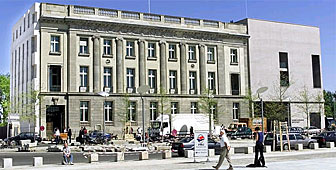
Controversial new Swiss embassy opens in Berlin

The new jewel in the crown of Switzerland's diplomatic representations, the revamped embassy in Berlin, opens on Friday with a lavish ceremony. The new embassy has aroused considerable controversy - both for its architecture and in the person of the ambassador's wife.
About 200 guests, including the Swiss president, Moritz Leuenberger, are attending the opening party.
Many eyes, however, will also be on Shawne Fielding, wife of ambassador Thomas Borer. Her revealing pictures for a German magazine last week caused a storm, and initial doubts whether she would be allowed to attend the event.
She confirmed her attendance on Wednesday after the row was settled.
In an interview with swissinfo, Borer declared himself “very pleased” with the restoration work on the palace and the new annexe.
“It’s very difficult to compete with this old palais of 1870, which is even older than the Reichstag, the German parliament, which is a pretty unique building, but I think the new annexe shows that Switzerland has a very modern architecture, which is even, I would say, avant-gardist.”
Borer added that it was a unique experience for him, as an ambassador, to be opening an embassy, especially one in such a prominent location and with such a rich history as Berlin.
The embassy – a renovated palace close to the spanking new German chancellery along the Spree River – has left public opinion divided about its architectural merit.
The 19th century building survived World War Two and the Cold War, but many people now wonder aloud whether it has been dealt a fatal blow by the architects who renovated it.
Basel architects Diener and Diener supervised the SFr22 million renovation and extension of the embassy, which remained empty for half a century. The concrete cube annexe, which was added to the old building, has attracted more than its fair share of criticism.
It represents a complete break in style, retaining none of the visual elements of the palace. Locals have called the cube a bunker or a prison, and the newspaper “Die Welt” described it as an “ugly duckling” and a “step backwards for Switzerland”.
The architects say their decision was based not only on aesthetic considerations, but also took the building’s history into account. The new and the old stand together, they say, as a reminder of the turbulent times the city has gone through and as a witness to the new Germany.
The new embassy has also won plaudits. The Berlin authorities are grateful that the renovated palace still stands along that stretch of the Spree as a reminder of the past
Most of the surrounding area has been one of Europe’s biggest building sites in recent years. At the end of the Cold War, the no man’s land where East refused to meet West became the continent’s most sought after real estate.
The formerly vacant Potsdamer Platz has become a multi-billion dollar high-tech business district, a reminder of its busy past. And the vast new German chancellery opened last week just next door to the Swiss embassy.
The Swiss authorities had a hard time retaining their valuable real estate, the only building in the neighbourhood to survive World War Two bombing raids. The original plans for the chancellery and the new administrative zone did not include an embassy in their midst.
But the Swiss hung on, despite pressure from the Germans and proposals to move elsewhere. “Trust the Swiss to get a good spot” is a much heard comment in Berlin these days.
Built in 1871 for the director of the Charité hospital, the embassy has been the property of the Swiss government since the end of the World War One. It was also the scene of what some historians call one of Swiss diplomacy’s darkest hours.
Switzerland’s ambassador to the Third Reich, Hans Fröhlicher, wined and dined Nazi officials within its walls during the war.
Some believe this was to curry favour with the Nazis, others to keep Hitler’s army from invading Switzerland.
The truth lies probably somewhere in between. And like the two dissimilar sections of the embassy, history is somewhere between the extremes.
by Scott Capper

In compliance with the JTI standards
More: SWI swissinfo.ch certified by the Journalism Trust Initiative




























You can find an overview of ongoing debates with our journalists here . Please join us!
If you want to start a conversation about a topic raised in this article or want to report factual errors, email us at english@swissinfo.ch.